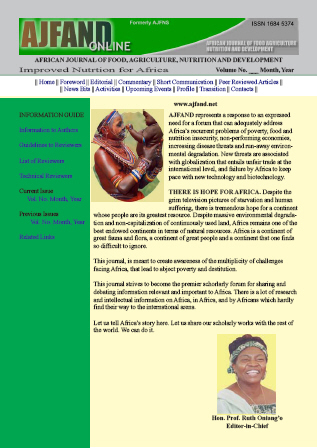
|
African Journal of Food, Agriculture, Nutrition and Development
Rural Outreach Program
ISSN: 1684-5358 EISSN: 1684-5374
Vol. 1, Num. 2, 2005
|
Untitled Document
African Journal of Food Agriculture Nutrition and Development, Vol. 5, No. 2 , 2005
Book Review
Soy
protein and formulated meat products by Henk W. Hoogenkamp
Oiye Shadrack and Hon. Prof. Ruth Oniang'o
Code Number: nd05032
In this issue we have included reviews of a few books that we thought are
important in the field of food, agriculture, nutrition and development. Please
read and
tell us what you think
Title: Soy protein and formulated meat products
Author: Henk W. Hoogenkamp
Publisher: CABI Publishing
Reviewer: Oiye Shadrack and Hon. Prof. Ruth Oniang'o
This book is an important and comprehensive account of the historical, nutritional,
social and technological aspects of soy protein processing, focusing on variably
possible formulations composed of soy concentrates and isolates as functional
ingredients. The book - designed to interest advanced students and professionals
in human nutrition as well and food and meat science and technology - argues
that unlocking the potential of nature to improve quality of life is the single
greatest challenge for soy protein nutrition. Basic knowledge in food science,
food technology, nutrition and related issues is key to the understanding of
important complexes between interrelated aspects of soy protein. For this reason,
Henk W. Hoogenband spends quite a significant number of initial chapters in
this book to highlight some basic aspects, including the history of soy, meat
processing, microbiology, lifestyle foods paradigms, nutrition-related illnesses
and practices, and genetically modified organisms. One conspicuous observation
is the simplicity and care that attends to the presentation of basic facts
and contentious issues.
Quite a wide range of emulsified meat, meat pate, sausage and poultry formulations
are given in tabular forms. Prior to these presentations, there is a whole
chapter on the functional non-meat protein properties. Functional non-meat
protein ingredients can be of animal or vegetable origin, and both can be used
in processed meat products. It is, however, noted that during the last decade
of the 20th century, the cost factor, processing capabilities and flavor improvements
of soy protein have led to considerable erosion of milk protein market domination.
Improved soy protein functionality, including gel strength, emulsification
and removal of beany soy flavor, have slowly encroached on usage of milk protein
which was previously the most ideal fat-water emulsifier in finely comminuted
meat products. In the formulations presented in this book, soy protein in form
of isolates and concentrates are included particularly to replace the meat
and poultry levels, and for functional reasons. Three main fractions in functional
soy protein have been discussed namely; fat-soluble protein, soluble aggregate
and insoluble aggregate.
After a detailed account in relevant chapters of technological issues on particular
types of meat products, formulations and explicit processing procedures for
various meat products are annexed. No warranties, however, expressed or implied,
are made on suggested formulations. Based on this information, it is suggested
that the formulae should be evaluated on a small-scale prior to a full-scale
production, and that the information contained in the book should not be construed
as permission for violation of trademarks or patent rights. The last chapter
on protein-enhanced fresh meat is particularly interesting. Modern time-trapped
consumers demand a centre-of-the-plate meat portion that can be prepared in
minutes – not hours. Ease of preparation at home thus needs to be part
of the solution. Protein-stabilized, moisture-enhanced fresh meat - which is
discussed in this chapter - is one key to that solution, being less intimidating
and more forgiving during cooking and preparation.
It is evident that the author's objective of making soy a strategic
ingredient in menu meat and food items for global powerhouse of franchised
food restaurants is met. The only question is, however, ‘How many readers
will believe him?'It is also clear from the book, that there is a wide
window of opportunity to solve the challenge of soy industry and to find new,
attractive, and technologically sound ways to develop great-tasting, affordable
foods while at the same time educating the public about soy protein's
nutritional and health benefits. The book provides new insights and current
understanding in the area of nutritional assessment. This is a must read for
all students and practicing nutritionists.
Copyright
2005 - Rural Outreach Program
|
